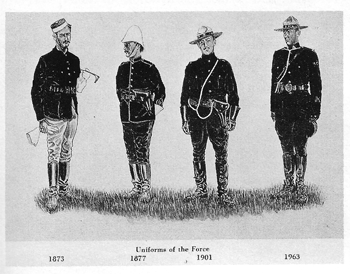![]() EARLY LAW AND ORDER
EARLY LAW AND ORDER
The subject of law and order is difficult to pinpoint within any given area. It is a very broad subject as law enforcement officers are rapidly transferred from one detachment to another. In the pre-1910 years patrols covered vast areas of Alberta and detachments were opened when and where needed and closed when problems were solved.
The earliest report of police activities in this area is of Corporal Ralph Bateman Sleigh of the North-West Mounted Police. He was born at Bradbourne, Derbyshire, England on July 14, 1858, the third son of John Sleigh who was living at Eversley, Matlock, England when Ralph joined the Force at Fort Walsh on June 7, 1881.
Sleigh was promoted to the rank of Corporal on July 23, 1883. Unfortunately the early personnel files do not record every detachment at which the members were stationed. However we do know that Sleigh was stationed at Frog Lake in 1884 and possibly patrolled there earlier.
The Frog Lake Detachment was opened in 1884 when unrest among the Indians made closer supervision imperative. Strength of this detachment was one corporal and four constables, Corporal Sleigh in charge. The reason for Corporal Sleigh and his men leaving Frog Lake prior to the Massacre is explained in the official Mounted Police account of the North-West Rebellion, found elsewhere in this book. After the uprising was quelled, danger of more trouble from the Indians appeared remote and this little detachment was closed. Corporal Sleigh was killed in the fight between the Indians and government forces at Cut Knife Hill, North- West Territories, on May 2, 1885, just one month after the Frog Lake Massacre.
In 1886 a detachment was opened at Onion Lake, Saskatchewan, with Divisional Head quarters at Battle- ford, and Frog Lake and surrounding districts came under its patrol. Frog Lake is approximately thirty miles from Onion Lake.
Delinquent members of the early society were apparently taken for trial to Battleford, Fort Pitt, Onion Lake or wherever a magistrate, Justice of the Peace or other judiciary officer was available.
Districts as mentioned in the Early History of N.W.M.P. at Onion Lake, Saskatchewan could mean anywhere within the area from Island Lake east, to Saddle Lake west, and Cold Lake north.
The scarlet of the uniform was impressive; south of the border the color was blue, which to the Indians meant treachery and broken promises. Scarlet stood for protection and the straight tongue.



